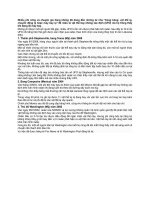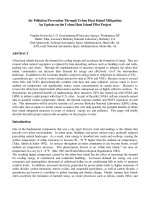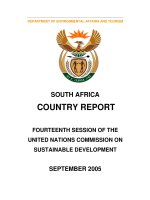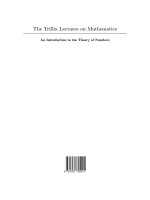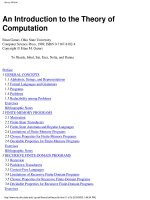- Trang chủ >>
- Khoa Học Tự Nhiên >>
- Vật lý
as if an enemys country the british occupation of boston and the origins of revolution feb 2010
Bạn đang xem bản rút gọn của tài liệu. Xem và tải ngay bản đầy đủ của tài liệu tại đây (2.57 MB, 305 trang )
As If an Enemy’s Country
PIVOTAL MOMENTS
IN AMERICAN HISTORY
Series Editors
David Hackett Fischer
James M. McPherson
James T. Patterson
Brown v. Board of Education: A Civil Rights Milestone and Its Troubled Legacy
Maury Klein
Rainbow’s End: The Crash of 1929
James M. McPherson
Crossroads of Freedom: The Battle of Antietam
Glenn C. Altschuler
All Shook Up: How Rock ’n’ Roll Changed America
David Hackett Fischer
Washington’s Crossing
John Ferling
Adams vs. Jefferson: The Tumultuous Election of 1800
Joel H. Silbey
Storm over Texas: The Annexation Controversy and the Road to Civil War
Raymond Arsenault
Freedom Riders: 1961 and the Struggle for Racial Justice
Colin G. Calloway
The Scratch of a Pen: 1763 and the Transformation of North America
Richard Labunski
James Madison and the Struggle for the Bill of Rights
Sally McMillen
Seneca Falls and the Origins of the Women’s Rights Movement
Howard Jones
The Bay of Pigs
Elliott West
The Last Indian War: The Nez Perce Story
Lynn Hudson Parsons
The Birth of Modern Politics: Andrew Jackson, John Quincy Adams, and the Election of 1828
Glenn C. Altschuler and Stuart M. Blumin
The GI Bill: A New Deal for Veterans
As If an
enemy’s
Country
The British Occupation
of Boston and the
Origins of Revolution
RICHARD ARCHER
2010
Oxford University Press, Inc., publishes works that further
Oxford University’s objective of excellence
in research, scholarship, and education.
Oxford New York
Auckland Cape Town Dar es Salaam Hong Kong Karachi
Kuala Lumpur Madrid Melbourne Mexico City Nairobi
New Delhi Shanghai Taipei Toronto
With offi ces in
Argentina Austria Brazil Chile Czech Republic France Greece
Guatemala Hungary Italy Japan Poland Portugal Singapore
South Korea Switzerland Thailand Turkey Ukraine Vietnam
Copyright © 2010 by Richard Archer
Published by Oxford University Press, Inc.
198 Madison Avenue, New York, New York 10016
www.oup.com
Oxford is a registered trademark of Oxford University Press
All rights reserved. No part of this publication may be reproduced,
stored in a retrieval system, or transmitted, in any form or by any means,
electronic, mechanical, photocopying, recording, or otherwise,
without the prior permission of Oxford University Press.
Library of Congress Cataloging-in-Publication Data
Archer, Richard, 1941–
As if an enemy’s country : the British occupation
of Boston and the origins of revolution / Richard Archer.
p. cm. — (Pivotal moments in American history)
Includes bibliographical references and index.
ISBN 978-0-19-538247-1
1. United States—History—Revolution, 1775–1783—Causes.
2. Boston (Mass.)—History—Colonial period, ca. 1600–1775.
I. Title.
E210.A73 2010
973.3—dc22 2009039919
135798642
Printed in the United States of America
on acid-free paper
For Julie Mayo, Steve Archer, and Steve Mayo
This page intentionally left blank
Contents
List of Illustrations, ix
Editor’s Note, xi
Introduction: A Garrisoned Town, xiii
Chapter 1: Grenville’s Innovation, 1
Chapter 2: On the Brink, 20
Chapter 3: Power and the Opposition, 39
Chapter 4: An Accommodation of Sorts, 48
Chapter 5: The Townshend Blunder, 65
Chapter 6: A Momentous Decision, 82
Chapter 7: Camping on the Common, 104
Chapter 8: Occupation, 123
Chapter 9: The Merchants and John Mein, 144
Chapter 10: Prelude to a Tragedy, 166
Chapter 11: The Massacre on King Street, 182
Chapter 12: Aftermath, 207
Conclusion: A Revolutionary Legacy, 226
Acknowledgments, 231
Notes, 233
Works Cited, 265
Index, 275
This page intentionally left blank
Illustrations
Map of Boston, 1769 xv
A South East View of the Great
Town of Boston in New England
in America xvii
The Right Honourable George
Grenville, fi rst Lord
Commissioner of the Admiralty 2
Thomas Hutchinson 12
The Hon. James Otis, jun. Esq 13
A View of the Year 1765 25
Sir Francis Bernard 29
Samuel Adams 41
Boston Affairs 46
A View of the Obelisk Erected under
Liberty-tree on the Rejoicings for
the Repeal of the Stamp Act 1766 51
Town House as of 1785 56
The Right Honble. William Pitt,
Earl of Chatham 66
The Right Honble. Charles
Townshend Esq., late Chancellor
of the Exchequer 67
John Hancock 84
General Sir Thomas Gage 93
The Town of Boston in New England
and British Ships of War Landing
Their Troops! 1768 105
A Prospective View of Part of the
Common 112
Castle William 125
x | Illustrations
Grenadier of the 29th Regiment 128
Boston Chronicle 151
Boston Gazette 154
View of Faneuil-Hall in Boston,
Massachusetts 167
Life and Humble Confessions of
Richardson 180
Map of central Boston 186
Brattle Street Church 189
Boston Massacre 194
Map of people at the Boston Massacre 199
John Adams 217
Editor’s Note
Ten generations after the event, Americans still vividly remember their
Great Revolution—and in very different ways. As these words were
written on September 12, 2009, tens of thousands of angry taxpayers were
marching through the streets of Washington. Some wore eighteenth-
century dress. They remembered the Revolution as a revolt against
taxation, and even against government itself—“Don’t Tread on Me!”
Other Americans remember their Revolution as a larger movement,
for a government that might actively protect many rights of the people,
and serve their vital interests. An empathetic English leader observed in
1775 that the American colonists were moved by a multitude of “moral
causes,” and they felt deeply threatened by imperial oppression in many
ways at once. They sought a strong and effective self-government that
would respect rights of conscience, promote security of property, expand
liberty of trade, and preserve trial by jury. Seamen in New England de-
manded protection against impressment. Hunters in North Carolina
claimed a natural right to move beyond the mountains. Woodsmen in
New Hampshire were outraged when imperial offi cials branded the
King’s broad arrow on their biggest trees and seized them for the Royal
Navy. Teamsters in Delaware asserted their ancestral right to drive to
Pennsylvania without being stopped by British customs offi cers. And
people in many colonies regarded the presence of British troops as an
army of occupation. Each of these many confl icts caused outbreaks of
explosive violence before 1775.
This new book by Richard Archer reminds us that many Americans
most deeply feared and loathed the tyranny of a standing army in their
midst. This was specially the case in Boston, where on October 1, 1768, a
fl eet of British warships anchored in a ring around that unruly seaport,
and three regiments of British infantry marched ashore with bayonets
fi xed. Town-born Bostonians perceived these redcoated regulars as in-
vaders, and saw them as a double threat to liberty from arbitrary power,
and freedom to govern themselves as they had always done.
xii | Editor’s Note
The events that followed in Boston make a story of high drama,
which is at the very heart of the American Revolution. No novelist could
have invented the fi rst collision. It happened at Boston’s Manufactory
House, a place of refuge for poor, ill, and homeless townfolk. Offi cials
ordered their removal so that a regiment could be quartered there.
The homeless refused to go, and an attempt was made to evict them
by force. A “scuffl e” followed, with swords and bayonets against tools
and brooms. To everyone’s amazement the homeless won and the troops
retreated—not a good omen for the empire. Other scenes followed, with
increasing violence. On the night of March 5, 1770, an angry mob rioted
against the British troops. In turn, the angry soldiers rioted against the
civilians, fi red without orders, and fi ve people died.
Many large themes run through the stories that are told in this book.
One of them is about the mobilization of Boston’s radical Whigs—not
one group but many, and deeply divided in their thoughts and acts. Their
leaders struggled to keep the Whig spirit growing, but also to keep it in
bounds. Men such as Samuel Adams and John Adams were determined
to win, but also mindful of the moderates. It is interesting to watch these
very skillful politicians at work.
Another and more poignant theme is about the emergence of
American loyalists. In 1765, the colonists had been nearly united against
the Stamp Act. After 1766 they began to divide. Some deeply believed
that the protection of human rights required both liberty and order.
Boston’s loyalist clergyman Mather Byles observed that he had less to
fear from one tyrant three thousand miles away than three thousand
tyrants one mile away. By 1775, New Englanders were speaking of the
confl ict not as a revolution but as a civil war.
Yet a third theme appeared in the cross-purposes of imperial leaders
such as General Thomas Gage. They also thought of themselves as Whigs,
and cherished the traditions of the English Revolution of 1688. Many were
deeply divided within themselves. And the British troops in Boston were a
trial for them as well. Edmund Burke observed that an army of occupation
was “fully as diffi cult to be kept in obedience” as the people of the town.
The result was a fatal combination of assertion and hesitation, aggression
and retreat. In the pages of this fascinating book, we observe these events
as a web of choices that caused the American Revolution, shaped its conse-
quences, and are still evident in our divided purposes.
David Hackett Fischer
Introduction
A Garrisoned Town
Ambivalence about military power is not new to our era. English-
speaking people in the eighteenth century supported their military
during wartime. That was fortunate, for the British were engaged in
combat against the French and their allies throughout a substantial part
of the Northern Hemisphere for much of the 1700s. Expanding the
British Empire and protecting existing territory seemed a worthy use of
armed might. Offi cers chose (and purchased) military careers, soldiers
and sailors enlisted when other options were worse or on occasion
were impressed to service against their will, and the general citizenry
reluctantly paid taxes, grateful that their involvement went no further.
1
A standing army during peacetime, on the other hand, was
something altogether different. British people had long believed
that, rather than protecting the population and promoting imperial
interests, its purpose was to enforce the will of those in power. It was
a threat to basic British rights. To ensure that the military would be
kept in check, Parliament authorized the army for only twelve months
at a time by annually renewing the Mutiny Act, a bill that regulated
mutinies and desertions and, most important, established the means
for quartering and supplying troops, without which an army could
not exist. On March 24, 1765, Parliament ominously extended the
provisions of the Mutiny Act to its American colonies with the creation
of the Quartering Act. Although its apparent rationale was to provision
regiments and smaller units that temporarily dwelled in towns as they
moved from one place to another, colonists felt threatened by the
possibility of standing armies placed in their midst.
2
And they would
be proved right.
xiv | As If an Enemy’s Country
Bostonians, more than most other Americans, considered themselves
especially vulnerable. They were in the forefront of opposition to
British revenue bills and enforcement of trade regulations. Following
political protests in August 1765, when residents intimidated offi cials
by physical harassment and destruction of private property, the British
ministry perceived Boston popular leaders, including James Otis Jr.
and Samuel Adams, as emerging rebels who required close monitoring
and tightened supervision. Witnesses to recurring confl icts with Crown
offi cials and reinforced by the time-honored fear of standing armies,
Boston newspaper editors published articles elaborating on how such
power would undermine inherent rights and spread rumors speculating
on the imminent arrival of troops. Even the royal appointee, Lieutenant
Governor Thomas Hutchinson, warned in October 1767, after the passage
of a tax on paper, glass, lead, painters’ colors, and tea, “It is impressed in
the minds of the people that these Duties are a prelude to many more
much heavier and that a Standing Army is to enforce Obedience and the
Legislative power of the Colonies to be taken away.” And on September
27, 1768, the minister of the New North Church, Andrew Eliot, lamented
and prophesized, “To have a standing army! Good God! What can be
worse to a people who have tasted the sweets of liberty! Things are come
to an unhappy crisis; there will never be that harmony between Great
Britain and her colonies, that there hath been; all confi dence is at an end;
and the moment there is any blood shed, all affection will cease.”
3
A day later, on September 28, six ships of war and two armed schooners
sailed into Boston Harbor, augmenting at least six other British naval
vessels already present. Onboard were the 14th and 29th Regiments, two
companies of the 59th Regiment, and an artillery detachment. Two days
later, in preparation for landing the troops, the war ships maneuvered
closer to the town and ranged themselves as if for a siege. At about noon
on Saturday, October 1, the two armed schooners and boats from the
ships docked on the Long Wharf, a pier that jutted nearly two thousand
feet out into the harbor, where fi rst the 14th Regiment disembarked.
With drums beating, fi fes playing, and fl ags streaming, soldiers marched
along the wharf past the shops and warehouses and continued up King
Street, stopping at the Town House, the site of the colony’s House of
Representatives and Council, until the 29th Regiment arrived. The 29th
echoed the 14th’s pageantry, with the variation that the drummers of all
nine companies were Afro-Caribbean, attired in yellow coats with red
Boston, 1769. William Price’s 1769 revision of John Bonner’s map of Boston in 1722. Note that north is in the
direction of the upper right corner. (Historic Urban Plans, Inc., Ithaca, New York)
xvi | As If an Enemy’s Country
facing and lapels. From the Town House, the two regiments paraded up
a few short blocks of mixed residences and shops until they reached the
Common. By midafternoon the companies of the 59th and the artillery
detachment had joined them.
4
In all, roughly twelve hundred British soldiers and offi cers had landed
in Boston. In November two regiments from Ireland, the 64th and most
of the 65th, arrived, increasing the total to approximately two thousand.
5
Wives, children, and hangers-on accompanied the troops and enlarged
their impact, as did the crews and offi cers aboard the ships of war.
Their presence was an overwhelming and often hostile addition to
the town. As of the census of 1765, Boston had a total population of
15,520, a number that included slaves, apprentices, and servants, though
not the normal transients of a seaport. Within the provincial city, 2,041
were white males above the age of sixteen, and 510 were male “Negroes
and Molattoes” of all ages.
6
If we assume that there were as many as
fi ve hundred male transients (merely a guess, and a generous one),
adult males constituted no more than four thousand persons. In short,
during the British occupation of Boston, one man in three was a soldier.
Redcoats were everywhere, on duty and off. Theirs was not a casual or
unobtrusive presence. In the streets, along the ropewalks, in the taverns,
directly outside the Town House where the main guard was located, at
checkpoints, on the Common, daytime and night, the people of Boston
encountered the representatives of British power. They could not be
avoided.
Boston in 1768 was a much smaller city than we know it today.
Its entire circumference was merely four miles, and it was less than
three miles from the neck that linked the town to the mainland to the
northeastern corner, where the Charlestown ferry landing stood. The
bulk of the population resided either in the North End or the South
End, which together composed two-thirds of the peninsula. Taking a
brisk walk, in about an hour a person could see most of Boston, with its
three hills, wood buildings and residences, church spires, and wharfs.
No sidewalks aided the pedestrian, nor were there streetlamps providing
light after dark.
7
The British troops upon landing may have been pleased with what
they saw. Three years earlier Lord Adam Gordon had described Boston
as “more like an English Old Town than any in America.” But they
would have been foolish to assume that familiarity meant welcome.
xvii Introduction |
Though they had not experienced the violent confrontation that had
been rumored, for the most part they were met with sullen stares and
silence. More overt opposition would come soon enough. “All is at
present quiet,” Andrew Eliot wrote in mid-October, “but there is a
general gloom and uneasiness.” He portrayed Boston as a garrisoned
town, a recurring characterization used by town residents. Over time, the
resentment grew. On April 15, 1769, the Massachusetts Council, writing
the Earl of Hillsborough, secretary of state for the American colonies,
complained that the secrecy and circumstances attending the landing
of troops in Boston were “as if in an Enemy’s Country.”
8
The ministry
was treating American colonies, Boston in particular, as alien land, and
colonists, Bostonians in particular, recognized the change. Their loyalty
to England was shaken. The immediate issue facing them was how to
remove the occupying force. The larger issue was the colonies’ place
within the empire, and indeed whether there should be a place for them
within the empire.
Boston remained an occupied town for seventeen months, until the
tragic events of the evening of March 5, 1770. A year and a half is not long
by planetary standards—barely the beginning of a blink of an eye—but
for mere mortals it can be transformative; attitudes can change, new ideas
A South East View of the Great Town of Boston in New England in America, an
engraving by John Carwitham between 1730 and 1760. (Library of Congress)
xviii | As If an Enemy’s Country
develop, economic conditions alter, love bloom (and die), governments
be overthrown, believers convert, and peace sprout and shrivel. So much
is possible. Thirty-fi ve years after the occupation, Mercy Otis Warren,
a friend or relation of several Massachusetts leaders, wrote in her three-
volume 1805 history of the American Revolution that the “American
war may be dated from the hostile parade” of October 1, 1768, when
“several regiments were landed, and marched sword in hand through
the principal streets of their city, then in profound peace.”
9
In this book
I explore whether Warren’s assessment is accurate by examining what
decisions and events led to the military occupation of Boston, what
transpired while British troops were there, and what the consequences
were.
From Warren’s distance of slightly more than a quarter of a century,
and especially from our perspective of nearly a quarter of a millennium,
the revolutionary past appears to be determined. We are so familiar with
what occurred that we assume there were no alternatives. But neither
the occupation nor the American Revolution was inevitable. Human
will may be limited by the context of the time and the passions of the
moment, but it still is powerful. Other decisions could have been made;
other actions could have been taken. This is the story of the choices that
were made and the results that followed.
As If an Enemy’s Country
This page intentionally left blank
Chapter 1
Grenville’s Innovation
When he accepted the position of prime minister on April 16, 1763,
George Grenville could refl ect on how fortunate and privileged his fi rst
fi fty years had been. Educated at Eton and Oxford, called to the Bar, and
fi rst elected to Parliament at age twenty-nine, he joined his fi rst ministry
just three years later. Hard work, honesty, and the ability to master the
intricacies of fi nance contributed to his success, but family connections
should not be discounted. He had been elected to Parliament, after all, as
the benefi ciary of all thirteen votes in his uncle’s “pocket borough,” and
he was the brother-in-law of the charismatic and mercurial William Pitt,
the “Great Commoner.”
Not inclined to take risks, Grenville labored in the familial trenches
until 1760, when he broke with his more powerful older brother, Richard,
Earl Temple, and Pitt over what came to be called the Seven Years’
War. Seemingly out of character, he boldly chose to join the youthful,
new king, George III, and the king’s former tutor and ongoing mentor,
Lord Bute, in seeking peace. Although the American phase of the world
war, called the French and Indian War, concluded in September 1760
and the confl ict in India ended soon after, battles in Europe blazed on.
When Bute became prime minister in 1762, he rewarded Grenville
with the important ministerial position of secretary of state for the
Northern Department. Bute, not well liked beyond the king’s circle,
quickly showed his inexperience and poor judgment by secretly opening
preliminary discussions for peace with France without fi rst consulting
his cabinet. Grenville, demonstrating a surprising backbone, objected
to Bute’s unilateral initiative. Needing his parliamentary connections,
Bute retained Grenville in the ministry but demoted him to fi rst lord of
2
| As If an Enemy’s Country
The Right Honourable George Grenville, First
Lord Commissioner of the Admiralty, circa
1760, a mezzotint by James Watson based on
William Hoare’s painting. (Emmet Collec-
tion, Miriam and Ira D. Wallach Division
of Art, Prints and Photographs, The New
York Public Library, Astor, Lenox and Tilden
Foundations)
the Admiralty. After countering Pitt and Temple on the one hand and
objecting to Bute’s approach to peace on the other (on top of which, the
king considered him tedious), Grenville must have been surprised after
Bute’s resignation to fi nd himself head of the ministry.
1
Grenville inherited a complicated political situation. The most favor-
able circumstance was the offi cial conclusion of the Seven Years’ War.
The Treaty of Paris, with the accompanying Treaty of San Ildefonso,
gave Britain a resounding victory over France and a favorable
arrangement with France’s ally Spain. All of North America east of the
Mississippi River, including Canada and Florida (Florida at the time not
only designated the current state but also today’s gulf coast Alabama and
Mississippi), was now under British rule. France forfeited its territorial
3
Grenville’s Innovation |
claims in India and militarily retreated in Europe. The West Indies
retained its European imperial cast, but Britain brought several more
islands into its empire. Without a doubt, Great Britain had become
the dominant world power. No European nation could equal Britain’s
hegemony, and only insular China might have been a genuine rival.
2
As always, such power came at a great cost. To defeat the French and
their allies, the British under William Pitt spent as if they had unlimited
resources. Near bankruptcy accompanied their triumph. The overall
national debt nearly doubled during the war to almost 150 million
pounds sterling. Interest on the debt alone required about half of the
total annual revenue (9.8 million pounds). Collecting proved a problem
as the war’s costs mounted. Taxes on beer, tobacco, and other items dear
to ordinary citizens supplemented traditional property taxes. When
Parliament passed a tax on cider at the war’s end and the beginning of
a postwar depression, residents of cider-producing counties rose up in
public and noisy protest.
3
Disturbances in the home country were only a part of the disarray that
confronted Grenville. Despite occasional ministerial stabs at bringing
about administrative oversight and coherent policy, the colonies, for the
most part, ran as local enterprises. The Crown appointed governors,
lieutenant governors, and sometimes councils, but popularly elected
assemblies who paid the offi cials’ salaries and raised revenue for
government oper ations checked the mother country’s power. Diverted
by warfare, the empire, by default, was more a federation of affi liated
states than a centrally organized institution.
In the waning months of Bute’s short ministry, he and his colleagues,
with strong prompting from George III, decided to retain a substan-
tial portion of the army in the postwar empire. They did not desire to
return to the lower troop levels existing prior to the Seven Years’ War.
The world, their world, had changed. Defeated nations might want to
reclaim and expand their territories; non-English residents of Canada,
Nova Scotia, East Florida, and West Florida might grow restive; and
there was always the possibility that contact between colonial settlers and
traders on the one side and Indians of the Ohio Country on the other
would lead to violence. There also was the problem of reducing the
offi cer corps. Forced retirement would mean half-pay for many offi cers
who held seats in Parliament or whose relations did, and George III
and Bute were well aware of the potential impact on patronage; and
4
| As If an Enemy’s Country
the king, like previous Hanoverian monarchs, held a vital interest in
the protection of his military.
4
All were good reasons for maintaining a
large, permanent army. So much for the peace dividend.
The traditional antipathy to a standing army, the state of the national
debt, and the resistance to new taxes in Great Britain together demanded
clever solutions by the Bute ministry to gain parliamentary approval.
Reducing the number of soldiers by half while retaining nearly all offi cers
had several virtues. Not only would there be a signifi cant fi nancial
savings, but it would keep the administrative structure in place. Should
there be a military emergency, the return to wartime strength could
be rapid, with enlisted men joining existing regiments. The ministry
shrewdly decided that there would be somewhat fewer soldiers in
Britain, alleviating fears among the home population of military abuse.
The increase would be located in Ireland, where six thousand troops
would be stationed (still in the British Isles but not in England), and in
North America, where ten thousand soldiers and offi cers, three times
the prewar level, would be placed, far exceeding what was required for
security. The number of troops there and in Ireland represented the needs
of the empire as a whole, for regiments could be transported wherever
there was trouble. What was important to the Bute ministry was keeping
no more than a normal military profi le in the mother country.
But no matter where the army was located, it still would be costly.
From the perspective of London, the solution was obvious: fi nd funding
elsewhere. When George III disingenuously claimed that the expenses of
the postwar military establishment would be a hundred pounds cheaper
than in 1749, he meant that they would be cheaper for the taxpayers of
England, not that overall costs would be reduced. The Irish Parliament
was responsible for paying for the troops in its midst, and American
colonists had a similar obligation for their ten thousand. With little
debate, Parliament approved the enlarged peacetime army.
5
Grenville then faced the monumental task of simultaneously achieving
fi nancial solvency and establishing imperial order and sovereignty. He
began by implementing and improving the administration of existing
law. In the previous year, as fi rst lord of the Admiralty, he had pushed
for the enactment of a bill authorizing British ships of war to enforce
trade laws. He had added the incentive that crews would share half the
proceeds from unlawful merchant ships they seized. The objective was
to increase revenue from trade duties by preventing smuggling. The
